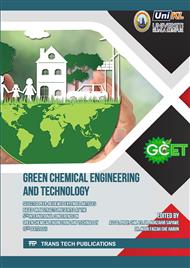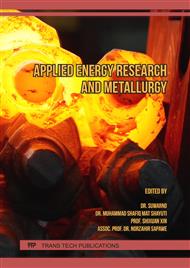[1]
ASTM C141 / C141M-14 2014 Standard Specification for Hydrated Hydraulic Lime for Structural Purposes (Pennsylvania: ASTM).
Google Scholar
[2]
A.A. Mohamed-Sabri and M.Z. Suleiman, Study of the Use of Lime Plaster on Heritage Buildings in Malaysia: A Case Study in George Town, Penang Advanced Green Material and Technology Symposium (AGMTS 2014) Vol 17 (Penang: MATEC Web of Conference) pp.1-6 (2014).
DOI: 10.1051/matecconf/20141701005
Google Scholar
[3]
K.S. Kamal, L. Ab Wahab and G. Ahmad, Pilot Survey on The Conservation of Historic Buildings in Malaysia 2nd International Conference on Built Environment in Developing Countries (ICBEDC) (Penang: USM) pp.104-115 (2008).
Google Scholar
[4]
A.M. Forster, How hydraulic lime binders work: hydraulicity for beginners and the hydraulic lime family, Edinburgh: Love Your Building Publishing, (2004).
Google Scholar
[5]
A.M. Forster, E.M. Szadurski and P.F.G Banfill, Deterioration of natural hydraulic lime mortars I: Effects of chemically accelerated leaching on physical and mechanical properties of uncarbonated materials, Construction and Building Materials. 72 (2014) 199-207.
DOI: 10.1016/j.conbuildmat.2014.09.015
Google Scholar
[6]
A. Moncmanová, Environmental factors that influence the deterioration of materials, WIT Transactions on State of the Art in Science and Engineering, 28 (2007) 11-25.
DOI: 10.2495/978-1-84564-032-3/01
Google Scholar
[7]
S. Pavía, R. Walker, P. Veale and A. Wood, Impact of the Properties and Reactivity of Rice Husk Ash on Lime Mortar Properties, Journal of Materials in Civil Engineering. 26(9) (2014) 1-8.
DOI: 10.1061/(asce)mt.1943-5533.0000967
Google Scholar
[8]
M. Erans, A.N. Seyed and V. Manović, Carbonation of lime-based materials under ambient conditions for direct air capture, Journal of Cleaner Production. 242 (2020) 1-8.
DOI: 10.1016/j.jclepro.2019.118330
Google Scholar
[9]
B. Birgisson, and M. Dham. Optimization of Clay Addition for Enhancement of Pozzolanic Reaction in Nanomodified Cement Paste, in K. Gopalakrishnan, B. Birgisson, P.C. Taylor and N. O. Attoh-Okine (Eds.), Nanotechnology in Civil Infrastructure: A Paradigm Shift, Springer Verlag, 2011, p.223–236.
DOI: 10.1007/978-3-642-16657-0_8
Google Scholar
[10]
M. Wyrzykowskia, A. Assmann, C. Hesse and P. Lura, Microstructure development and autogenous shrinkage of mortars with C-SH seeding and internal curing, Cement and Concrete Research. 126 (2020) 1-12.
DOI: 10.1016/j.cemconres.2019.105967
Google Scholar
[11]
T.A. Gebrehiwet, G.D. Redden, Y. Fujita, M.S. Beig and R.W. Smith, The Effect of the CO32- to Ca2+ Ion activity ratio on calcite precipitation kinetics and Sr2+ partitioning, Geochemical Transactions. 13(1) (2012) 1-11.
DOI: 10.1186/1467-4866-13-1
Google Scholar
[12]
R.M.H. Lawrence, T.J. Mays, P. Walker and D. D'Ayala, Determination of carbonation profiles in non-hydraulic lime mortars using thermogravimetric analysis, Thermochimica Acta, 444(22) (2006) 179-189.
DOI: 10.1016/j.tca.2006.03.002
Google Scholar
[13]
K. Ezziane, A. Bougara, A. Kadri, H. Khelafi and E. Kadri, Compressive strength of mortar containing natural pozzolan under various curing temperatures, Cement & Concrete Composites. 29(8) (2007) 587-593.
DOI: 10.1016/j.cemconcomp.2007.03.002
Google Scholar
[14]
T. Skoulikidis, D. Charalambous and K. Tsakona, Amelioration of the properties of hydrated lime for the consolidation of the surface or/and the mass of building materials of monuments or new buildings or statues and ornaments, translated by Berlin: Elsevier Science. (1996).
Google Scholar
[15]
C.F. Liang and H.Y. Wang, Feasibility of Pulverized Oyster Shell as a Cementing Material, Advances in Materials Science and Engineering. (2013) 1-7.
DOI: 10.1155/2013/809247
Google Scholar
[16]
G.L. Yoon, B.T. Kim, B.O. Kim and S.H. Han, Chemical-mechanical characteristics of crushed oyster-shell, Waste Management. 23(9) (2003) 825–834.
DOI: 10.1016/s0956-053x(02)00159-9
Google Scholar
[17]
S.H. Eo and S.T. Yi, Effect of oyster shell as an aggregate replacement on the characteristics of concrete, Magazine of Concrete Research. 67(15) (2015) 833-842.
DOI: 10.1680/macr.14.00383
Google Scholar
[18]
D. Zhang, J. Zhao, D. Wang, C. Xu, M. Zhai and X. Ma, Comparative study on the properties of three hydraulic lime mortar systems: Natural hydraulic lime mortar, cement-aerial lime-based mortar, and slag-aerial lime-based mortar, Constr. Build. Mater. 186 (2018) 42-52.
DOI: 10.1016/j.conbuildmat.2018.07.053
Google Scholar
[19]
D. Shanmugavel, R. Dubey and R. Ramadoss, Use of natural polymer from plant as admixture in hydraulic lime mortar masonry, Journal of Building Engineering. 30 (2020) 1-11.
DOI: 10.1016/j.jobe.2020.101252
Google Scholar
[20]
J. Thamboo and M. Dhanasekar, Assessment of the characteristics of lime mortar bonded brickwork wallets under monotonic and cyclic compression. Construction and Building Materials, 261 (2020).
DOI: 10.1016/j.conbuildmat.2020.120003
Google Scholar
[21]
A.M. Forster, N. Razali, E.M. Szadurski and C. Torney, The influence of calcitic filler in natural hydraulic lime for high humidity and temperature climatic conditions: a preliminary investigation, in J.J. Hughes, J. Válek, C.J.W.P. Groot (Eds.), Historic Mortars: Advances in Research and Practical Conservation, Springer, Cham, 2019, pp.201-211.
DOI: 10.1007/978-3-319-91606-4_15
Google Scholar
[22]
C. Martínez-García, B. González-Fonteboa, D. Carro-López and F. Martínez-Abella, Effects of mussel shell aggregates on hygric behaviour of air lime mortar at different ages. Construction and Building Materials 252 (2020).
DOI: 10.1016/j.conbuildmat.2020.119113
Google Scholar
[23]
C. Martínez-García, B. González-Fonteboa, D. Carro-López and F. Martínez-Abella , Impact of mussel shell aggregates on air lime mortars: Pore structure and carbonation. Journal of Cleaner Production 215 (2019) 650-668.
DOI: 10.1016/j.jclepro.2019.01.121
Google Scholar
[24]
N.B. Razali, Natural Hydraulic Lime Mortars for Use in High Temperature, High Humidity Climatic Conditions: Effect of Calcitic Fillers PhD. Thesis (Edinburgh: Heriot-Watt University) (2014).
DOI: 10.1007/978-3-319-91606-4_15
Google Scholar
[25]
J.M. Juez, B. Cazacliu, A. Cothenet, R. Artoni and N. Roquet, Recycled concrete aggregate attrition during mixing new concrete, Construction and Building Materials. 16 (2016) 299-309.
DOI: 10.1016/j.conbuildmat.2016.04.131
Google Scholar
[26]
A. Costigan, S. Pavía, O. Kinnane, An experimental evaluation of prediction models for the mechanical behavior of unreinforced, lime-mortar masonry under compression. Journal of Building Engineering, 4 (2015) 283-294.
DOI: 10.1016/j.jobe.2015.10.001
Google Scholar
[27]
V. Rasanen and V. Penttala, The pH measurement of concrete and smoothing mortar using a concrete powder suspension, Cem. Concr. Res. 34(5) (2004) 813–820.
DOI: 10.1016/j.cemconres.2003.09.017
Google Scholar
[28]
W. Kubissa and R. Roman Jaskulski, Measuring and time variability of the sorptivity of concrete, Procedia Engineering. 57 ( 2013 ) 634–641.
DOI: 10.1016/j.proeng.2013.04.080
Google Scholar
[29]
B. Khasanov, L. Irmuhamedova, G. Firlina and T. Mirzaev, Theoretical foundations of the structure formation of cement stone and concrete. IOP Conf. Ser.: Mater. Sci. Eng. 869 (2020) 1-10.
DOI: 10.1088/1757-899x/869/3/032032
Google Scholar
[30]
N. Razali, M.A. Azizan, K.F. Pa'ee, N. Razali and N. Jumadi, Preliminary studies on calcinated chicken eggshells as fine aggregates replacement in conventional concrete. Materials Today: Proceedings, 31 (1) (2020) 354-359.
DOI: 10.1016/j.matpr.2020.06.232
Google Scholar
[31]
M. Apostolopoulou, D.J. Armaghani, A. Bakolas, M.G. Douvika, A. Moropoulou, P.G. Asteris, Compressive strength of natural hydraulic lime mortars using soft computing techniques. Procedia Structural Integrity, 17 (2019) 914-923.
DOI: 10.1016/j.prostr.2019.08.122
Google Scholar
[32]
S. Thirumalini, R. Ravi and M. Rajesh, Experimental investigation on physical and mechanical properties of lime mortar: Effect of organic addition. Journal of Cultural Heritage, 31 (2018) 97-104.
DOI: 10.1016/j.culher.2017.10.009
Google Scholar
[33]
D. Hatungimana, C. Taşköprü, M. İçhedef, M.M. Saç, Ş. Yazıcı. Compressive strength, water absorption, water sorptivity and surface radon exhalation rate of silica fume and fly ash-based mortar. Journal of Building Engineering, 23 (2019) 369-376.
DOI: 10.1016/j.jobe.2019.01.011
Google Scholar
[34]
T.B. Su-Cadirci, C. Ince, J. Calabria-Holley, R. Kurchania and R.J. Ball, Use of brick waste for mortar-substrate optimisation of mortar-masonry systems. Construction and Building Materials 301 (2021).
DOI: 10.1016/j.conbuildmat.2021.124256
Google Scholar
[35]
S.W. Lee, Y.N. Jang and J.C. Kim, Characteristics of the Aragonitic Layer in Adult Oyster Shells, Crassostrea gigas: Structural Study of Myostracum including the Adductor Muscle Scar. Evidence-Based Complementary and Alternative Medicine (2011).
DOI: 10.1155/2011/742963
Google Scholar
[36]
M. Lanzón, & P.A. García-Ruiz, Lightweight cement mortars: Advantages and inconveniences of expanded perlite and its influence on fresh and hardened state and durability. Construction and Building Materials, 22(8), 1798-1806 (2008).
DOI: 10.1016/j.conbuildmat.2007.05.006
Google Scholar
[37]
M.N.N Khan & P.K. Sarker, Effect of waste glass fine aggregate on the strength, durability and high-temperature resistance of alkali-activated fly ash and GGBFS blended mortar. Construction and Building Materials, 263, 120177 (2020).
DOI: 10.1016/j.conbuildmat.2020.120177
Google Scholar
[38]
H.T. Van, L.H. Nguyen, V.D. Nguyen, X.H. Nguyen, T.H. Nguyen, T.V. Nguyen, S. Vigneswaran, J. Rinklebe & H. N. Tran, Characteristics and mechanisms of cadmium adsorption onto biogenic aragonite shells-derived biosorbent: Batch and column studies. Journal of Environmental Management, 241, (2019) 535–548.
DOI: 10.1016/j.jenvman.2018.09.079
Google Scholar



